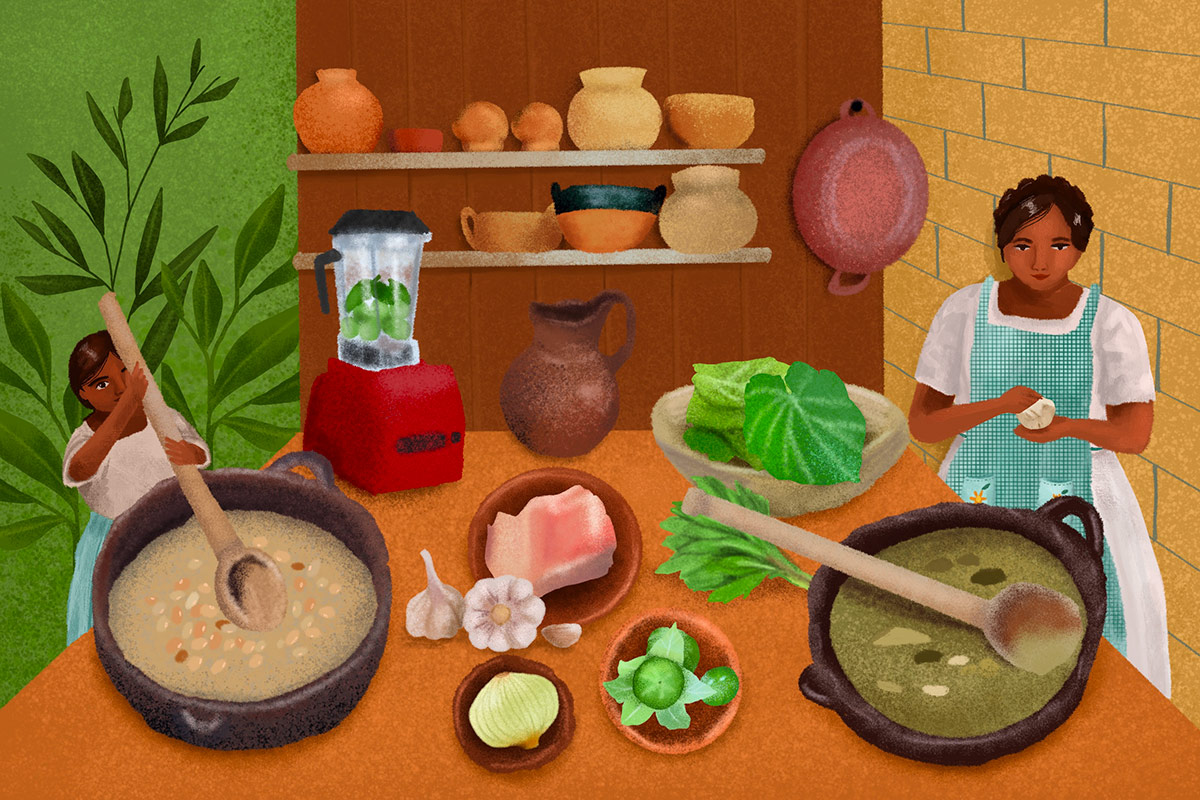Flavors from Memory and “OaxaCalifornia”: The Cookbooks of Bricia Lopez

“Cocinando con nuestras abuelas” (Cooking with our grandmothers) portrays how Mexican kitchens are an intergenerational learning space.
Illustration by Sitalin Sánchez
Reading a cookbook is like reading a piece of history. Cookbooks contain more than recipes. You can find genealogies, personal stories, and even cultural and political transformations while reviewing the steps to make a delicious meal. For chef Bricia Lopez, writing two cookbooks became an exercise in encountering her ancestors’ knowledge, generating cross-cultural dialogue, and ultimately challenging static notions of Mexico’s cuisine.
Born and raised in San Pablo Villa de Mitla in the Mexican state of Oaxaca, until her family moved to Los Angeles, California, when she was ten, Lopez is now a Oaxacan cultural ambassador lovingly known as the Mezcal Queen of Los Angeles. As a chef and entrepreneur, she frequently travels across the United States to share her love for “OaxaCalifornia” cuisine and culture.

In 2019, she published her first cookbook, Oaxaca: Home Cooking from the Heart of Mexico. Her second book, Asada: The Art of Mexican-Style Grilling, came out in 2023. As a participant in the 2024 Smithsonian Folklife Festival program, Indigenous Voices of the Americas: Celebrating the National Museum of the American Indian, Lopez will prepare mole verde, a traditional Oaxacan dish, and host a Happy Half Hour featuring her I Love Micheladas Original Brown Michelada Mix at the Foodways demonstration kitchen. These recipes, like all those she included in her cookbooks, include complex flavors and deep memories.
“Every wonderful memory I have is connected to food,” she says. “Food feeds your body, but it also feeds your soul.”
The Lopez family home state, Oaxaca, is located in southern Mexico. Its cuisine merges culinary traditions from at least sixteen Indigenous groups, Afro-Mexican populations, and Spanish traditions. Lopez and her three siblings grew up cooking and celebrating Oaxaca’s complex and regionally diverse cuisine.
“It is our responsibility to record this diversity and to share our culture,” she says.
Lopez’s first cookbook documents her family’s culinary memory through carefully crafted recipes passed through generations. “There are recipes my grandfather, my father, and I grew up eating.” In the second, she unveils the particularities of the Oaxacan cuisine born in Los Angeles. Mexican cuisine is not a monolith. There are multiple cuisines of Mexico, inside and beyond the country’s borders, wherever the diaspora spreads.
“There is a particular Oaxacan-Los Angeles cuisine. It is a cuisine that showcases spices, meat, and citrus.” As in many other immigrant communities, the Oaxacan diaspora in California has created a cuisine that belongs to two countries.
For Lopez, cooking recipes connected to your history and culture can teach you who you are. Recipes push you to use utensils, cultivate ingredients, and ultimately reproduce actions from people who came before you. In doing so, we experience the world in a way they once did. With her two cookbooks, she hopes future generations can engage with her history. “At some point, I won’t be here, but my cookbooks will be. Everything is there.”


Detailing her culture and family history in a book was a challenging process. In the case of Oaxaca: Home Cooking from the Heart of Mexico, it required several months.
“When you’re talking to your family, to your mom or your tía, trying to learn their recipes, they tell you, ‘Ay no sé. I put a little bit of this, a little bit of that.’ Nobody gives you a recipe.”
Knowing that so many Mexican recipes rely on oral knowledge and traditional cooking measurements, Lopez traveled back to Oaxaca and spent most of her time in the kitchen of her family’s house. Every time her mother was cooking, she took notes about the steps and put every ingredient on a kitchen scale. “I wanted to know what it means—un puñito, una pizca, un chorrito.”
Cookbooks can’t replace the wisdom behind oral history in food. However, they have their own value. They pause time, encapsulating ways of life waiting to be part of our homes.
For the 2024 Smithsonian Folklife Festival, Lopez intentionally chose to make mole verde to highlight the Indigenous presence in Mexico’s cuisine. “Mole verde is not famous, but this mole highlights masa flavor, corn flavor—flavors created by Indigenous people.” Among other fragrant herbs, this recipe uses hoja santa and epazote, plants native to Central America.
Even though recipes with long histories may require ingredients that are hard to find, Lopez encourages people to try. “There was a time when you couldn’t find key ingredients to make Chinese or Indian food, and now they’re available.” Searching for and demanding ingredients that are part of your heritage or you are interested in is a way to make diversity visible in the United States.
“USA cuisine comes from a diversity of cultures,” Lopez says. “All the people coming here can also be a lead influence in this country’s cuisine.”
Sitalin Sánchez is a Smithsonian Folklife Festival intern in the Indigenous Latinx specialization. She is a Nahua artist and research assistant at the Moses Mesoamerican Archive and Research Project.

